英语倒装句型
- 格式:docx
- 大小:25.81 KB
- 文档页数:9
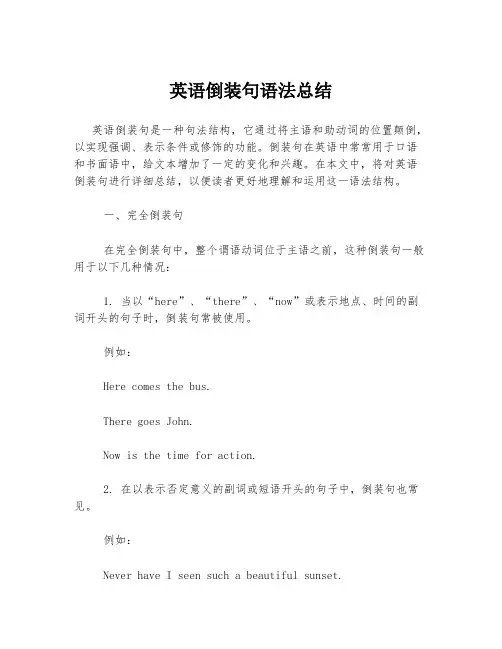
英语倒装句语法总结英语倒装句是一种句法结构,它通过将主语和助动词的位置颠倒,以实现强调、表示条件或修饰的功能。
倒装句在英语中常常用于口语和书面语中,给文本增加了一定的变化和兴趣。
在本文中,将对英语倒装句进行详细总结,以便读者更好地理解和运用这一语法结构。
一、完全倒装句在完全倒装句中,整个谓语动词位于主语之前,这种倒装句一般用于以下几种情况:1. 当以“here”、“there”、“now”或表示地点、时间的副词开头的句子时,倒装句常被使用。
例如:Here comes the bus.There goes John.Now is the time for action.2. 在以表示否定意义的副词或短语开头的句子中,倒装句也常见。
例如:Never have I seen such a beautiful sunset.Not only is she talented, but she is also kind-hearted.3. 在以“only”开头修饰状语从句的句子中,倒装句也经常使用。
例如:Only when you face your fears can you overcome them.Only in this way can the problem be solved.二、部分倒装句部分倒装句中,只将助动词或情态动词放在主语之前,而将主语与谓语动词的位置维持原状。
部分倒装句常用于以下几种情况:1. 当以否定副词“never”、“seldom”或“rarely”开头时,部分倒装句可以被采用。
例如:Never have I been so happy.Seldom does he complain about anything.2. 在以“so”或“such”引导的句子中,为了表达强调,可以使用部分倒装句。
例如:So tired was she that she fell asleep on the couch.Such is the power of love that it can conquer all obstacles.3. 在以“not”开头的句子中,为了增强否定的语气,常常使用部分倒装句。
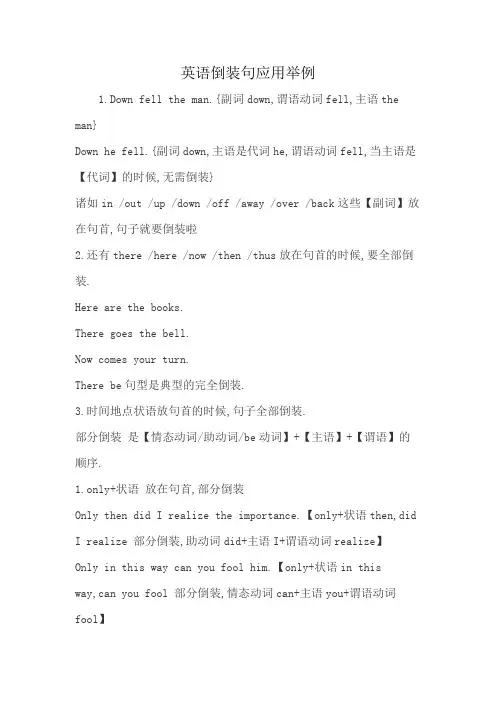
英语倒装句应用举例1.Down fell the man.{副词down,谓语动词fell,主语the man}Down he fell.{副词down,主语是代词he,谓语动词fell,当主语是【代词】的时候,无需倒装}诸如in /out /up /down /off /away /over /back这些【副词】放在句首,句子就要倒装啦2.还有there /here /now /then /thus放在句首的时候,要全部倒装.Here are the books.There goes the bell.Now comes your turn.There be句型是典型的完全倒装.3.时间地点状语放句首的时候,句子全部倒装.部分倒装是【情态动词/助动词/be动词】+【主语】+【谓语】的顺序.1.only+状语放在句首,部分倒装Only then did I realize the importance.【only+状语then,did I realize 部分倒装,助动词did+主语I+谓语动词realize】Only in this way can you fool him.【only+状语in this way,can you fool 部分倒装,情态动词can+主语you+谓语动词fool】Only when the class is over,can I see her.【only+when引导的状语从句放句首,从句不倒装,主句要到装】2.not until放句首Not until midnight did it stop raining.3.not only...but also...前倒后不倒Not only did he learn from books but also (he learned from) practice.[因为累赘,可将括号内容省略]4.Neither...nor...前后均倒装。

英语倒装句型知识点学英语的时候,倒装句型这一块儿可真是让人又爱又恨。
爱呢,是因为一旦掌握了,用起来那叫一个酷炫,感觉自己的英语水平瞬间高大上了;恨呢,是因为它有时候真的很让人迷糊,一不小心就出错。
咱先来说说啥是倒装句型。
简单来说,就是把句子里的语序颠倒一下,不是按照正常的主语在前谓语在后的顺序来。
比如说,正常的句子是“You are here”(你在这儿。
)但要是倒装一下,就成了“Here you are”(给你。
)是不是感觉挺神奇的?我记得有一次,老师在课堂上讲倒装句型,那场面,真的是永生难忘。
当时老师在黑板上写了一堆例句,然后声情并茂地给我们讲解。
我一开始还听得云里雾里的,满脑子都是问号。
老师可能是看出了我们的迷茫,就决定来个实战演练。
她指着教室角落里的一把扫帚,说:“In the corner of the classroom lies a broom”(在教室的角落里有一把扫帚。
)然后问我们:“那如果要说‘在桌子上有一本书’,应该怎么说?”大家都开始七嘴八舌地回答,有的说“On the desk has a book”,有的说“On the desk is a book”老师笑着摇摇头,说:“第一个错啦,应该是第二个‘On the desk is a book’这就是典型的地点状语在前,要使用倒装句型。
”接着,老师又出了一个难题:“Out rushed the children when the bell rang”(铃响了,孩子们冲了出去。
)然后让我们仿照这个句子造句。
我当时心里特别紧张,绞尽脑汁地想。
突然,我灵光一闪,举手说:“In came the teacher when we were making a noise”(我们正吵闹的时候老师进来了。
)老师听了,脸上露出了欣慰的笑容,说:“不错不错,看来你掌握得挺好。
”那一刻,我心里别提多得意了。
但是,别以为我就这样完全掌握了倒装句型,那可太天真了。

初中英语倒装句主语和谓语是句子的核心,它们之间有两种语序:一是主语在谓语之前称为自然语序(Natural Order);二是主语在谓语之后则称为倒装语序(Inverted Order)。
而倒装语序中又有完全倒装(Full Inversion)和部分倒装(Partial Inversion)完全倒装(Full Inversion):又称"全部倒装",是指将句子中的谓语动词全部置于主语之前。
此结构通常只用与一般现在时和一般过去时。
部分倒装(Partial Inversion):指将谓语的一部分如助动词或情态动词倒装至主语之前,而谓语动词无变化。
如果句中的谓语没有助动词或情态动词,则需添加助动词do, does或did,并将其置于主语之前。
英语句子的倒装一是由于语法结构的需要而进行的倒装,二是由于修辞的需要而进行的倒装。
前一种情况,倒装是必须的,否则就会出现语法错误;后一种情况,倒装是选择性的,倒装与否只会产生表达效果上的差异。
1 完全倒装:1 倒装句之全部倒装全部倒装是只将句子中的谓语动词全部置于主语之前。
此结构通常只用与一般现在时和一般过去时。
常见的结构有:1) here, there, now, then, thus等副词置于句首, 谓语动词常用be, come, go, lie, run。
There goes the bell.Then came the chairman.Here is your letter.2) 表示运动方向的副词或地点状语置于句首,介词短语作为地点状语置于句首,后面如果有lie, live, sit, stand, come, go等动词,全句需要全部倒装。
Out rushed a missile from under the bomber.Into the hall came three women.Ahead sat an old woman.3)存在句(there be/ live/ stand/ lie/ seem等)需要全部倒装。
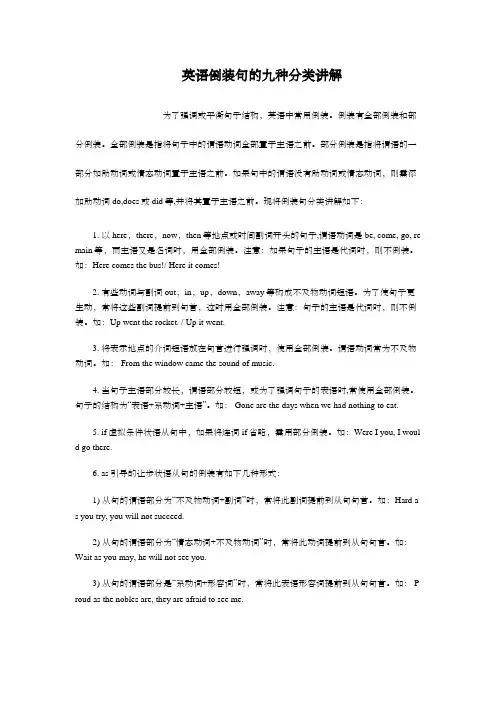
英语倒装句的九种分类讲解为了强调或平衡句子结构,英语中常用倒装。
倒装有全部倒装和部分倒装。
全部倒装是指将句子中的谓语动词全部置于主语之前。
部分倒装是指将谓语的一部分如助动词或情态动词置于主语之前。
如果句中的谓语没有助动词或情态动词,则需添加助动词do,does或did等,并将其置于主语之前。
现将倒装句分类讲解如下:1. 以here,there,now,then等地点或时间副词开头的句子,谓语动词是be, come, go, re main等,而主语又是名词时,用全部倒装。
注意:如果句子的主语是代词时,则不倒装。
如:Here comes the bus!/ Here it comes!2. 有些动词与副词out,in,up,down,away等构成不及物动词短语。
为了使句子更生动,常将这些副词提前到句首,这时用全部倒装。
注意:句子的主语是代词时,则不倒装。
如:Up went the rocket. / Up it went.3. 将表示地点的介词短语放在句首进行强调时,使用全部倒装。
谓语动词常为不及物动词。
如: From the window came the sound of music.4. 当句子主语部分较长,谓语部分较短,或为了强调句子的表语时,常使用全部倒装。
句子的结构为“表语+系动词+主语”。
如: Gone are the days when we had nothing to eat.5. if虚拟条件状语从句中,如果将连词if省略,需用部分倒装。
如:Were I you, I would go there.6. as引导的让步状语从句的倒装有如下几种形式:1) 从句的谓语部分为“不及物动词+副词”时,常将此副词提前到从句句首。
如:Hard a s you try, you will not succeed.2) 从句的谓语部分为“情态动词+不及物动词”时,常将此动词提前到从句句首。
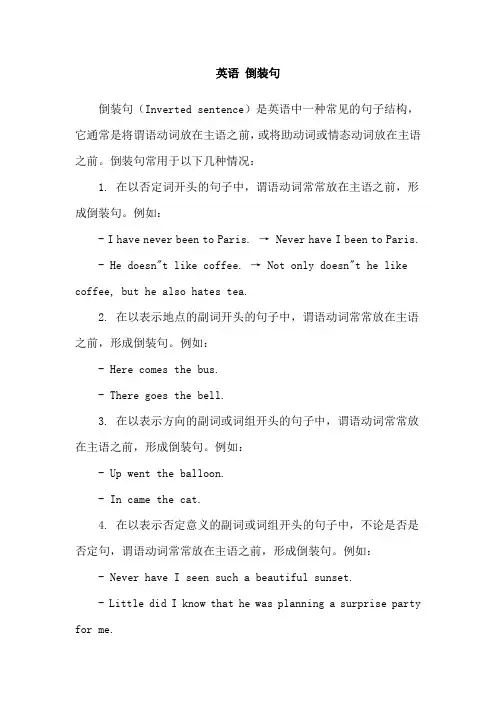
英语倒装句倒装句(Inverted sentence)是英语中一种常见的句子结构,它通常是将谓语动词放在主语之前,或将助动词或情态动词放在主语之前。
倒装句常用于以下几种情况:1. 在以否定词开头的句子中,谓语动词常常放在主语之前,形成倒装句。
例如:- I have never been to Paris. → Never have I been to Paris. - He doesn"t like coffee. → Not only doesn"t he like coffee, but he also hates tea.2. 在以表示地点的副词开头的句子中,谓语动词常常放在主语之前,形成倒装句。
例如:- Here comes the bus.- There goes the bell.3. 在以表示方向的副词或词组开头的句子中,谓语动词常常放在主语之前,形成倒装句。
例如:- Up went the balloon.- In came the cat.4. 在以表示否定意义的副词或词组开头的句子中,不论是否是否定句,谓语动词常常放在主语之前,形成倒装句。
例如:- Never have I seen such a beautiful sunset.- Little did I know that he was planning a surprise party for me.5. 在以“so + 形容词/副词”或“such + 名词”开头的句子中,谓语动词常常放在主语之前,形成倒装句。
例如:- So tired was he that he couldn"t stay awake.- Such was his talent that he became a famous musician.需要注意的是,倒装句并不是所有情况下都适用,而是在特定的语境和句型中使用的。
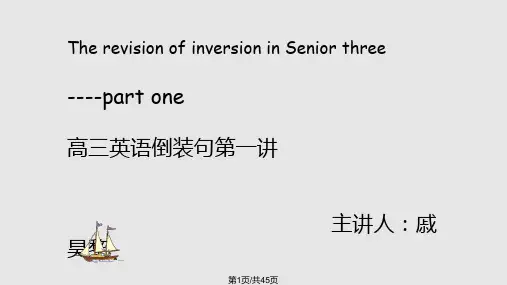

高考英语读后续写精彩倒装句(一)【句型公式】“So+ adj./adv.+ be 动词/助动词/情态动词+主语十that 从句”如此⋯⋯以至于⋯…【佳句背诵】1.So crowded were the concert that I hardly found my seat.(2023•新高考I卷)音乐会人山人海,我几乎找不到自己的座位。
2.So proud of Tommy was I that I knew never again would anyone mistake this boy for a bully!我为汤米感到骄傲,我知道再也不会有人把这个男孩错当成恶霸了!【佳句仿写】1.然而,大卫是如此坚定,他忽略了周围的一切,只是向前看。
(2022•新高考I卷)However, so determined was David that he ignored everything around him, only watching forward.2.金姆(Kim)的父母非常震惊,他们从沙发上跳起来,冲向金姆身边。
So shocked were Kim's parents that they jumped up from the sofa and rushed over to Kim.3.老人被这个男孩感动了,无法用语言表达他的感情。
So moved by the boy was the old man that words failed to convey his emotions.(二)【句型公式】“n./adj./adv.+as/though+主语+谓语,主句”尽管……【佳句背诵】1.Exhausted as he was, he still rushed to the finishing line.(2022• 新高考I卷)尽管筋疲力尽,他仍然冲向了终点线。
2.Afraid as he felt, he still knocked on the door, waiting breathlessly.尽管他感到害怕,但他仍然敲了敲门,气喘吁吁地等着。

英语完全倒装的15种句首标志,1引语2表语3非谓语4状语5类句式英语部分倒装的15种用法=1只有+2也不+3虚拟+4如此+5否定今天,我们我们来看引起完全倒装的15种句首标志。
首先放上第一张思维导图。
1种直接引语''Help! Help!'' shouted the boy. “救命!救命!”,男孩喊道。
解析:直接引语就是利用双引号直接引用某人说的话。
本句正常语序本应是The boy shouted, ''Help! Help!''. 谓语shouted完全放到主语the boy之前,构成完全倒装。
2种表语In each room are ten students. 在每个房间有10名学生。
(介词短语作表语)Present at the meeting were all the teachers of this school. 出席这次会议的是这所学校的所有老师。
(形容词作表语)Gone are the days when I was young. 我年轻的时光一去不复返了。
(形容词作表语)解析:以上三个都是“主语+系动词be+表语”的基本句式。
因为表语提前,必须变成“表+系+主”的完全倒装。
自己可以恢复成正常语序体会。
倒装佳句赏析:Green and green are the willows on the ferry. 渡头杨柳青青。
Green are the clouds in the sky and faded are the leaves on the ground. 碧云天,黄叶地。
3种非谓语动词Sitting in the wheelchair is an old man in his seventies.坐在轮椅上的是一位70多岁的老人。
To be particularly considered are the following questions.要被特别考虑的是以下问题。
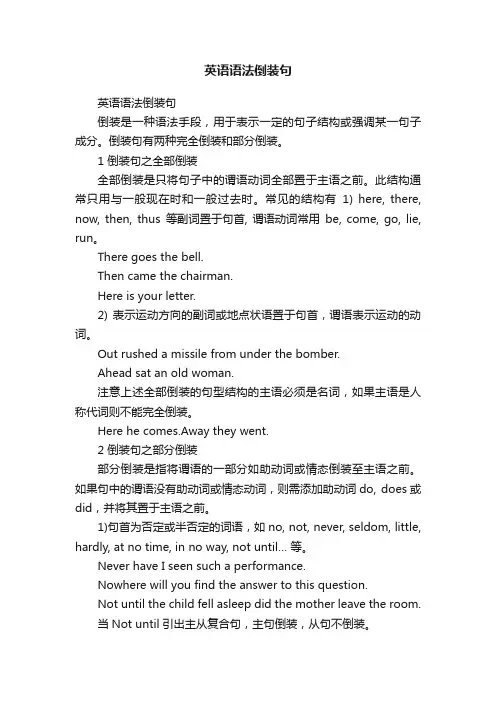
英语语法倒装句英语语法倒装句倒装是一种语法手段,用于表示一定的句子结构或强调某一句子成分。
倒装句有两种完全倒装和部分倒装。
1 倒装句之全部倒装全部倒装是只将句子中的谓语动词全部置于主语之前。
此结构通常只用与一般现在时和一般过去时。
常见的结构有1) here, there, now, then, thus等副词置于句首, 谓语动词常用be, come, go, lie, run。
There goes the bell.Then came the chairman.Here is your letter.2) 表示运动方向的副词或地点状语置于句首,谓语表示运动的动词。
Out rushed a missile from under the bomber.Ahead sat an old woman.注意上述全部倒装的句型结构的主语必须是名词,如果主语是人称代词则不能完全倒装。
Here he comes.Away they went.2 倒装句之部分倒装部分倒装是指将谓语的一部分如助动词或情态倒装至主语之前。
如果句中的谓语没有助动词或情态动词,则需添加助动词do, does或did,并将其置于主语之前。
1)句首为否定或半否定的词语,如no, not, never, seldom, little, hardly, at no time, in no way, not until… 等。
Never have I seen such a performance.Nowhere will you find the answer to this question.Not until the child fell asleep did the mother leave the room.当Not until引出主从复合句,主句倒装,从句不倒装。
注意如否定词不在句首不倒装。
I have never seen such a performance.The mother didnt leave the room until the child fell asleep.典型例题1)Why cant I smoke here?At no time___ in the meeting-roomA. is smoking permittedB.smoking is permittedC. smoking is it permittedD.does smoking permit答案A. 这是一个倒装问题。

英语倒装句语法英语倒装句在句子中的位置出现了颠倒。
通常情况下,英语句子的语序是主语在前,谓语动词在后,但在某些特定的情况下,我们需要将谓语动词放在主语之前,这就产生了倒装句。
一、完全倒装句完全倒装句是指将谓语动词完全移到主语之前,完全倒置。
这种倒装主要有以下几种情况:1. 在以“Here”、“There”开头的句子中,用于强调或者表示某个地方或情况的存在。
例如:Here comes the train.There goes the bus.2. 在以副词表示方向的地点状语前。
例如:Up went the balloon.Down came the rain.3. 在以“Only+状语”、“Not only+状语”开头的句子中。
例如:Only by working hard can you achieve success.Not only did he pass the exam, but he also got the top score.4. 在以“so/such+形容词/副词+名词”开头表示程度的句子中。
例如:So noisy was the party that I couldn't sleep.Such great progress have we made in science and technology.二、部分倒装句部分倒装是指将助动词或情态动词提到主语之前,而谓语动词仍然保持在主语之后。
这种倒装一般发生在以下几种情况:1. 在以“neither/nor”开头的句子中。
例如:Neither has she seen the movie, nor has she read the book.2. 在以“not+动词”、“no sooner+副词”、“hardly/scarcely+副词”开头的句子中。
例如:Not a single word did he say.No sooner had I arrived than it started to rain.Hardly had he left the house when it started to snow.3. 在以“never/seldom+谓语动词”开头的句子中。
英语中全倒装句子一、全部倒装(一)there be句型有时一些表示存在意义的不及物动词也可用于该句型,如:stand,lie,exist,live, remain,appear,come,happen,occur,rise等。
例句:Generally, there was a belief that the new nations should be sovereign and independent states, large enough to be economically viable and integrated by a common set of laws. (选自2007年Use of English)分析:该句是复合句,其中a belief与that the new nations should be sovereign and independent states互为同位语关系,形容词短语large enough to be...作定语修饰states。
译文:他们普遍认为新生的国家是拥有主权和完全独立的国家,大到经济上可运行良好,并由一套共同法律让各个新的独立国家联合起来。
(二)表示方向、地点的状语等词置于句首here, there, up, down, away, in, out, off等位于句首时,往往主谓倒装。
例句: Here is an example, which I heard at a nurses convention, of a story which works well because the audience all shared the same view of doctors.(选自2002年Text 1)分析:该句是复合句,which I heard at a nurses convention和which works well共同修饰story。
倒装句的条件掌握倒装句出现的条件和用法倒装句的条件及用法倒装句是英语语法中的一种特殊结构,在句子中改变了正常的主谓语序。
通过将动词或助动词移至主语之前,可以强调句子中的某一部分或表达特定的语义。
掌握倒装句的条件和用法对于理解和正确运用英语语法非常重要。
本文将详细介绍倒装句出现的条件和用法。
一、全部倒装在某些情况下,我们需要对句子进行全部倒装,即将谓语动词完全移到主语前面。
以下是一些典型的全部倒装的条件和用法:1. 在以表示地点、方向或方式的状语开头的情况下,通常需要全部倒装。
例如:- Up the mountain they climbed, enjoying the breathtaking view.(他们沿着山上爬,欣赏着令人惊叹的景色。
)- In the distance could be seen a beautiful castle.(远处可以看到一座美丽的城堡。
)2. 当表示条件的连接词"if"位于句首时,需要全部倒装。
例如:- If you study hard, you will pass the exam.(如果你努力学习,你会通过考试。
)3. 在以表示否定意义的副词或短语开头的情况下,也需要全部倒装。
例如:- Never have I seen such a breathtaking sunset.(我从未见过如此美丽的日落。
)- Under no circumstances can you leave the room.(无论如何你都不能离开这个房间。
)二、部分倒装除了全部倒装外,还有一种常见的倒装句形式是部分倒装,即只将助动词或情态动词位移到主语之前。
以下是一些典型的部分倒装的条件和用法:1. 在以否定副词或短语开头的情况下,需要部分倒装。
例如:- Not only is she intelligent, but she is also kind-hearted.(她不仅聪明,而且心地善良。
英语部分倒装用法归纳
1. 否定副词位于句首时的倒装 在正式文体中,never, seldom, rarely, little, hardly, scarcely, no sooner, no longer, nowhere 等含有否定意义的副词若位于句首,则其后要用部分倒装: I shall never forgive him. / Never shall I forgive him. 我永远不会宽恕他。 He seldom goes out for dinner. / Seldom does he go out for dinner. 他很少出去吃饭。 She hardly has time to listen to music. / Hardly does she have time to listen to music. 她几乎没时间听音乐。 He little realizes how important this meeting is. / Little does he realize how important this meeting is. 他不甚明白这个会议的重要性。 We had no sooner reached the airport than the plane took off. / No sooner had we reached the airport than the plane took off. 我们刚到机场,飞机就起飞了。 【注意】 (1) 对于not…until句型,当not until…位于句首时,其后的主句要用倒装语序: He didn’t leave the room until the rain stopped. / Not until the rain stopped did he leave the room. 雨停了之后他才离开这房间。 (2) 某些起副词作用的介词短语,由于含有否定词,若位于句首,其后要用部分倒装: On no accounts must this switch be touched. 这个开关是绝不能触摸的。 In [Under] no circumstances will I lend money to him.无论如何我也不会再借钱给他了。 但是,in no time(立即,马上)位于句首时,其后无需用倒装语序: In no time he worked out the problem. 他马上就算出了那道题。
2.“only+状语”位于句首时的倒装 当一个状语受副词only的修饰且置于句首时,其后用部分倒装语序: Only then did he realize that he was wrong. 到那时他才意识到他错了。 Only in this way are you able to do it well. 你只有用这种方法才能把它做好。 Only when he returned home did he realize what had happened. 当他回到家里时,才知道出了什么事。
3. “so+adj. / adv.”位于句首时的倒装 副词so后接形容词或副词位于句首时,其后用部分倒装: So cold was the weather that we had to stay at home. 天气太冷,我们只好呆在家里。 So fast does light travel that we can hardly imagine its speed. 光速很快,我们几乎没法想像它的速度。 So sudden was the attack that we had no time to escape. 袭击来得非常突然,我们来不及逃跑。
4.“so+助动词+主语”倒装 当要表示前面提出的某一肯定的情况也同样适合于后者,通常就要用“So+助动词+主语”这种倒装结构: You are young and so am I. 你年轻,我也年轻。 She likes music and so do I. 她喜欢音乐,我也喜欢。 If he can do it, so can I. 要是他能做此事,我也能。 【注意】 (1) 若前面提出某一否定的情况,要表示后者也属于同样的否定情况,则应将其中的so改为neither或nor: You aren’t young and neither am I. 你不年轻,我也不年轻。 She hasn’t read it and nor have I. 她没有读它,我也没有读。 (2) 注意该结构与表示强调或同意的“so+主语+特殊动词”结构的区别: "It was cold yesterday." "So it was." “昨天很冷。”“的确很冷。” "Father, you promised." "Well, so I did." “爸爸,你答应过的。”“嗯,是答应过。”
5. 由not only…but also引出的倒装 当not only…but also位于句首引出句子时,not only 后的句子通常用部分倒装形式: Not only is he a teacher, but he is also a poet. 他不仅是一位教师,而且是一位诗人。 Not only did he speak more correctly, but he spoke more easily. 不仅他讲得更正确,也讲得更不费劲了。
6. 虚拟条件句的省略与倒装 当if引导的虚拟条件从句中含有had, were, should等时,如将if省略,则要将had, were, should等移到主语前,构成倒装句: Had you come yesterday, you would have seen him.若你昨天来,你就会见到他了。 Should you require anything give me a ring. 如果需要什么,可以给我打电话。 Were it not for your help, I would still be homeless. 要不是你帮助,我会仍然无家可归。 【注意】省略if后提前的had不一定是助动词: Had I money, I would buy it. 假若我有钱,我就会买它。
完全倒装的四种主要类型
1. here 和there位于句首时的倒装 表示地点的here和 there位于句首时,其后用完全倒装形式。这类倒装句的谓语通常是动词be和come, go等表示移动或动态的不及物动词: Here’s Tom. 汤姆在这里。 There’s Jim. 吉姆在那儿。 Here comes the bus. 公共汽车来了。 There goes the bell. 铃响了。 There goes the last train. 最后一班火车开走了。 【注意】 (1) 以上倒装句中的谓语动词come和go不能用进行时态,即不能说 Here is coming the bus。 (2) 若主语为代词,则不倒装: Here I am. 我在这儿。/ 我来了。 Here it comes. 它来了。 (3) 其中的动词有时也可能是stand, lie, live等表示状态的动词(表示存在): There stood a desk against the wall. 靠墙放着一张书桌。 Once upon a time there lived a man known by the name of Beef. 从前有个人名叫比夫。
2. away和down等位于句首时的倒装 地点副词away, down, in, off, out, over, round, up 等位于句首时,其后用完全倒装语序。这类倒装句的谓语通常表示动态的不及物动词: Away went the runners. 赛跑选手们跑远了。 Round and round flew the plane. 飞机盘旋着。 The door opened and in came Mr Smith. 门开了,史密斯先生进了来。 Down came the rain and up went the umbrellas. 下雨了,伞都撑起来了。 【注意】 若主语为人称代词,则不能用倒装: Away he went. 他跑远了。 Down it came. 它掉了下来。
3. 状语或表语位于句首时的倒装 为了保持句子平衡或使上下文衔接紧密,有时可将状语或表语置于句首,句中主语和谓语完全倒装: Among these people was his friend Jim. 他的朋友吉姆就在这些人当中。 By the window sat a young man with a magazine in his hand. 窗户边坐着一个年轻人,手里拿着一本杂志。 【注意】 在表语置于句首的这类倒装结构中,要注意其中的谓语应与其后的主语保持一致,而不是与位于句首的表语保持一致。比较: In the box was a cat. 箱子里是一只猫。 In the box were some cats. 箱子里是一些猫。
4. 分词和不定式置于句首的倒装 有时为了强调,可将谓语部分的现在分词、过去分词或不定式置于句首,从而构成倒装: Buried in the sands was an ancient village. 一个古老的村庄被埋在这沙土之中。 Standing beside the table was his wife. 站在桌旁的是他的妻子。 To be carefully considered are the following questions. 下列问题要仔细考虑。
涉及only的倒装及考题分析
按英语习惯同,当“only+状语”位于句首时,其后句子要用部分倒装。如: Only then did he realize that he was wrong. 到那时他才意识到他错了。